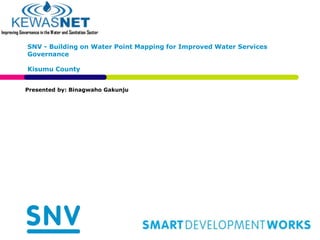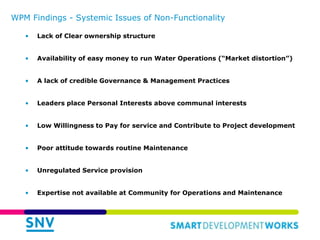10212014 KEWASNET SNV WPM RESULTS PRESENTATION - ISIOLO
- 1. SNV - Building on Water Point Mapping for Improved Water Services Governance Kisumu County Presented by: Binagwaho Gakunju
- 2. SNV Sector Focus WASH Agriculture Renewable Energy
- 3. Programmes in the WASH Sector 3 Sanitation Results Programme Non-revenue water Rural WASH (Water mapping, Functionality)
- 4. Context: The Sustainability Question for Rural Water 4 ŌĆó Post Construction support- a big challenge. ŌĆó Non-functionality 30-40% ŌĆó Rural data gap ŌĆó Management ŌĆśto think that communities can be empowered to manage fairly complex water systems no longer seems realistic. Just as it is utopian to think that the government can manage and maintain all the rural systemsŌĆ”ŌĆÖ
- 5. Functionality of Rural Water Supplies Approach 5 Partnership with KEWASNET
- 6. Water Point Mapping ŌĆó Water Point Mapping (WPM) has been defined as an exercise whereby the geographical positions of all Water Points (WPs) are gathered in addition to management, technical and demographical information. This information is collected using GPS and a questionnaire at each water point locationt. The data is entered into a geographical information system and then correlated with available demographic, administrative, and physical data. The information is displayed using digital maps (Water Aid, 2005). 6
- 7. Mandated Institutions - Why Water Point Mapping & After WPM 1. Evidence Based Policy and Investment planning 2. For effective targeting interventions (market) 3. Improved Equity and inclusion 4. Support coordination of WASH platforms 5. Monitoring and Evaluation ŌĆó Currently making the case for WPM in partner programme counties; ŌĆó End Goal 1 ŌĆō Institutionalising water point functionality monitoring for mandated institutions ŌĆó End Goal 2 ŌĆō Develop sustainable consumer feedback mechanisms as part of the service delivery approach
- 8. SNV Lessons ŌĆō Challenges of WPM Process ŌĆó Training and mobilisation of state and non-state actors took more time than expected ŌĆó Availability of community members to respond to some questions in the field (Institutional memory of water projects) ŌĆó Terrain - Difficulties in accessing some areas ŌĆó Weather conditions - Heavy rains and flooding in some areas caused delay, some days were not covered within the short time frame ŌĆó Community engagement - Lack of willingness to participate and community members being unaware of the exercise or expecting some financial gains before volunteering some information ŌĆó Security- A number of the areas are still riddled with high insecurity and cannot be accessed ŌĆó Development of sustainable updating mechanism for the data uptake 8
- 9. Some WPM Indicators ŌĆó Funded by (Whom/Year) ŌĆó Improved or Unimproved ŌĆó Length of time non-functional ŌĆó Reason for non-functionality ŌĆó Ownership ŌĆó Registered Service Provider ( through what means) ŌĆó Management Committee (In Place? By laws? Election process?) ŌĆó Number of women in management committee ŌĆó Estimated No of people served ŌĆó Quality standards assessment (Bacteriological, distance, sufficient quantities etc.) 9
- 10. 10
- 11. Results of WP Mapping 3 June 2015 Northern Water Services Board 11 ŌĆó The WPM process in Isiolo County began on 22nd May, 2013 and was carried out for a period of 30 days by 2 teams. ŌĆó A total of 267 water sources (229 WPs and 38 piped schemes) mainly within Central and Oldonyiro Divisions ŌĆó 75% of all mapped water sources are improved while 25% are unimproved ŌĆó The rest of this presentation only concerns the mapped points
- 12. Functionality Status ŌĆó Of the mapped points from improved sources, 61% are functional while the rest, about 39% are non- functional. 3 June 2015 Northern Water Services Board 12
- 13. Maintenance of WPs ŌĆó From the mapped points, the largest proportion at 31% of WP are not maintained at all and were at extreme risk of becoming non-functional. ŌĆó In 8% of the cases it was not clear if routine maintenance takes place. 3 June 2015 Northern Water Services Board 13
- 14. Management of WPs ŌĆó CBOs play a significant role in the management of WPs accounting for 41% of all improved WPs. Private individual manage 25% while 27% of WPs had no management system in place according to respondents ŌĆó Raises questions on the responsibility and accountability for service delivery 3 June 2015 Northern Water Services Board 14
- 15. Payment for water use ŌĆó Majority (58%) of WPs mapped supply water without requiring any payment for the services. 3 June 2015 Northern Water Services Board 15
- 16. WPM Findings - Systemic Issues of Non-Functionality ŌĆó Lack of Clear ownership structure ŌĆó Availability of easy money to run Water Operations (ŌĆ£Market distortionŌĆØ) ŌĆó A lack of credible Governance & Management Practices ŌĆó Leaders place Personal Interests above communal interests ŌĆó Low Willingness to Pay for service and Contribute to Project development ŌĆó Poor attitude towards routine Maintenance ŌĆó Unregulated Service provision ŌĆó Expertise not available at Community for Operations and Maintenance
- 17. WAY FORWARD ŌĆó Despite the challenges, the data from the exercise holds valuable information for stakeholders on systemic issues and best practices in management and operations of RWSS ŌĆó SNV is engaging stakeholders to leverage national and development partner resources to update and upscale Water Point Mapping (institutionalization, consumer feedback etc.) ŌĆó Policy and advocacy ŌĆō The value of combining evidence and collaboration to address issues of accountability (County WASH Platform tool) 17
Editor's Notes
- #3: SNV┬Āis an international┬Ānot-for-profit development organization. We believe that no-one should have to live in poverty and that all people should have the opportunity to pursue their own sustainable development. Founded in the Netherlands nearly 50 years ago, we have built a long-term, local presence where we are. Our global team of local and international advisors work with local partners to equip communities, businesses and organizations with the┬Ātools, knowledge and connections┬Āthey need to increase their incomes and gain access to basic services ŌĆō empowering them to┬Ābreak the cycle of poverty┬Āand guide their own development. By sharing our specialist expertise in┬ĀAgriculture,┬ĀRenewable Energy, and┬ĀWater, Sanitation & Hygiene, we contribute to solving some of the leading problems facing the world today ŌĆō helping to find local solutions to global challenges and sowing the seeds of lasting change.
- #5: Despite considerable investment in the rural water sector, around 18 million people (48%) currently use unimproved drinking water sources. It is unlikely that Kenya will meet MDG targets of access to safe drinking water unless there is a drastic shift in implementation strategy. ┬Ā It is the Sustainability of rural water supplies which has increasingly become a challenge. ┬Ā According to reports based on Water Point Mapping findings (SNV, 2010, 2013) this is attributed to the lack of a clear post construction management, operation and maintenance (O&M) system. ┬Ā This is supported by findings of the Value for Money Study which established that 57% of the entire water supply investment in rural areas of Kenya was unproductive because of non-functionality (Price Waterhouse Coopers, 2007). ┬Ā There are question marks that the community management model as currently used may not manage the cost of operation and maintenance, we need to look for other service delivery models at scale (PPPs with People-Public (Counties) and Private Sector) ┬Ā Over the years, SNV has partnered with UNICEF to implement a number of Program Cooperation Agreements that have embraced emerging approaches to help guarantee sustainability.

















